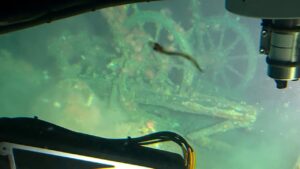Next month, David Reid, a veteran High Arctic outfitter now living in Ottawa, will lead a four-man, 650km manhauling expedition from Repulse Bay to Gjoa Haven in the Central Arctic, retracing the steps of the controversial Scottish explorer, John Rae.

David Reid. Photo Adventure Canada
While Rae was responsible for solving the two great mysteries of 19th-century arctic exploration, “he’s been ripped off by history,” according to Canadian author, Ken McGoogan.
In 1854, Rae and his two indigenous companions discovered the final link of the Northwest Passage, joining the Atlantic and Pacific Oceans. On the same journey, Rae learned the fate of the Franklin expedition, which had set out almost a decade earlier to find the Northwest Passage. Sir John Franklin and 128 sailors aboard the HMS Erebus and HMS Terror perished in the Royal Navy’s worst polar expedition disaster.
Their disappearance was one of the great mysteries of the Arctic. Rae met Inuit who told him that a party of around 40 white men had died of starvation on King William Island, and had resorted to cannibalism in a desperate attempt to stay alive.

John Rae. Photo arcticreturn.com
When he returned to London and duly reported this to the British Admiralty, Rae became the target of a brutal shaming campaign by the British establishment, led by Sir John Franklin’s widow, Lady Jane Franklin, and renowned author Charles Dickens. Dickens vilified the Inuit as savages and liars. Lady Franklin sought to remove Rae from the history of arctic exploration and to destroy his reputation.
Like Rae, David Reid was born in Scotland and first worked for the Hudson Bay Company in the Arctic. Reid subsequently became an outfitter based in Pond Inlet, on northern Baffin Island. He has been involved in over 300 Arctic and Antarctic expeditions. The main purpose of this personal journey is to raise awareness of Rae’s achievements and to help raise money to restore Rae’s birthplace, the Hall of Clestrain, built in Orkney in 1789.
The idea for Reid’s Arctic Return expedition first came from a meeting between Reid and McGoogan in 2017. “Everyone knew about Scott, Amundsen and Shackleton, but very few people knew of Rae,” Reid said.
The pair subsequently announced the project in a presentation to the Explorers Club. “There were 60 to 70 people there, and when we asked who had heard of John Rae, only six hands went up. That sealed the deal.”
Reid spent the next twelve months putting the project together. He will be joined by Richard Smith, a former Royal Marine Commando, and two Canadians: filmmaker Gary Tutte and adventurer and writer Frank Wolf. McGoogan won’t be trekking but will later help write the expedition book.
They plan to leave Naujaat (Repulse Bay) on March 25 and travel 500km west on skis and snowshoes, following Rae’s route across the Boothia Peninsula to Point de la Guiche. From there, it is another 160km across the sea ice of Rae Strait to Gjoa Haven, on King William Island. They expect the unsupported expedition to take around 40 days.
The story of John Rae
Born in Orkney, Scotland in 1813, Rae studied medicine at Edinburgh University and then came to Canada to work as a surgeon and clerk at an HBC post in northern Ontario for 10 years. Here, he learnt hunting, travel and survival skills from the First Nations and Metis people.
When the HBC Governor-in-Chief, Sir George Simpson, tasked Rae to finish the mapping of the Arctic coast, Rae first snowshoed 2,000km to a settlement where he could learn surveying. Contemporaries described the energetic Rae as “active as a squirrel.”
Despite his competence, the attempts to minimize his accomplishments largely succeeded, until recently. As late as 2009, memorials outside the Admiralty headquarters and inside Westminster Abbey still credited Franklin with discovering the Northwest Passage. It wasn’t until 2014 that Parliament unveiled a plaque in Westminster Abbey recognizing Rae’s achievements.
Historians studying Rae’s expeditions, including McGoogan, recognize Rae as the foremost specialist of his time in cold-climate survival and travel due to his willingness to adopt and learn the ways of the indigenous Inuit. “What set him apart was that he came and learned from the Inuit,” McGoogan said. McGoogan’s books have helped highlight Rae’s role in the saga of the Northwest Passage, so it is natural for him to be involved in such a project.

The route. Photo: arcticreturn.com
“This is an opportunity to tell the great story that is John Rae and highlighting the universal lessons that he learned from the way he conducted his explorations,” said David Reid. “First, respect people and talk to the locals. Second, equip yourself with the necessary knowledge and skills. Finally, don’t be afraid to tell the truth.”
For further information: arcticreturn.com






